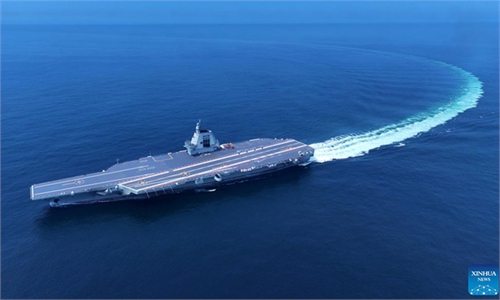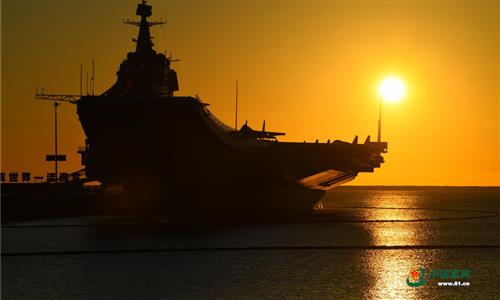
The aircraft carrier Liaoning battle group steam on the sea. The aircraft carrier Liaoning (Hull 16), several guided-missile destroyers, frigates and dozens of aircraft attached to the Navy of the Chinese People's Liberation Army took part in a combat exercise at an unidentified area east of the Bashi Channel in the western Pacific on Apr. 20, 2018. The exercise was a routine arrangement as a part of the PLA Navy's annual training plan. (eng.chinamil.com.cn/Photo by Zhang Lei)
The Chinese Foreign Ministry on Wednesday urged Japan to view activities by Chinese naval vessels from an objective and reasonable perspective, after the Japanese side said it had spotted the aircraft carrier Liaoning among a number of warships of the Chinese People's Liberation Army (PLA) Navy sailing into the Western Pacific through the Miyako Strait on Tuesday.
In response to a Reuters question on Japanese defense ministry's claim that Chinese aircraft carrier Liaoning passed by the southern islands of Japan and is heading toward the Western Pacific, with Japan keeping a close watch, why the Chinese aircraft carrier is so close to Japan and whether China is sending a message to Japan, the US and Taiwan region, Chinese Foreign Ministry Spokesperson Mao Ning referred the specific question to competent Chinese authorities.
"What I can tell you is that China's military vessels' activities in relevant waters are fully consistent with international law and international practice. We hope Japan will view this from an objective and reasonable perspective," she said at the regular press conference.
Japan first reported the activities by the aircraft carrier Liaoning on Sunday. According to a press release by Japan's Ministry of Defense Joint Staff, the Japanese Maritime Self-Defense Force on Sunday spotted a group of five PLA Navy warships, including the aircraft carrier Liaoning, two Type 052D guided missile destroyers and two Type 054A guided missile frigates, sailing in waters about 200 kilometers north of Huangwei Yu, an islet near Diaoyu Dao, with fighter jets and helicopters conducting takeoff and landing operations on the Liaoning.
Then on Tuesday evening, Japan's Ministry of Defense Joint Staff issued another press release saying that multiple PLA Navy warships including the Liaoning had operated in the East China Sea from Sunday to Monday, hosting about 90 fighter jet takeoff and landing operations and about 30 helicopter takeoff and landing operations, before sailing toward the Pacific Ocean through waters between Okinawa and the Miyako islands on Tuesday, with a Type 055 large destroyer joining the flotilla.
PLA Navy aircraft carriers conduct far seas exercises on a regular basis, often involving transiting the Miyako Strait in accordance with the international law and international practices, according to openly available reports.
Before the Japanese reports, the PLA Daily revealed that the Liaoning had recently conducted damage control exercises, without giving details on exactly when and where the exercises took place.
The exercises by the aircraft carrier Liaoning are likely a normal training activity, said Wang Yunfei, a Chinese military affairs expert.
Wang told the Global Times that generally speaking, an aircraft carrier spends about one third of its time under maintenance, one third of its time conducting training exercises, and one third of its time in combat alert duties, which also involves combat drills.
This means similar drills will only increase as China's aircraft carrier program continues to develop, Wang said.



